NEW YORK, March 18 – I apologize to my readers about the infrequent blog posts in the last several months. I’ve been dealing with a lot of life changes. I’ve also decided to move the blog over to a private server due to the increasingly prohibitive restrictions of blogger and the personal desire to expand the content on the site. Over the next several months, I will be transitioning slowly over to my own domain name (www.raiwebs.com). Hopefully by July, the entire blog will be fully transferred over to the private hosting server.
The Random Access Information Blog has moved to a new URL address. You can find new posts at: raiwebs.com
Showing posts with label Japanese Cinema. Show all posts
Showing posts with label Japanese Cinema. Show all posts
Friday, March 18, 2011
Tuesday, November 9, 2010
Kaiju Heroes: Men in Rubber Suits
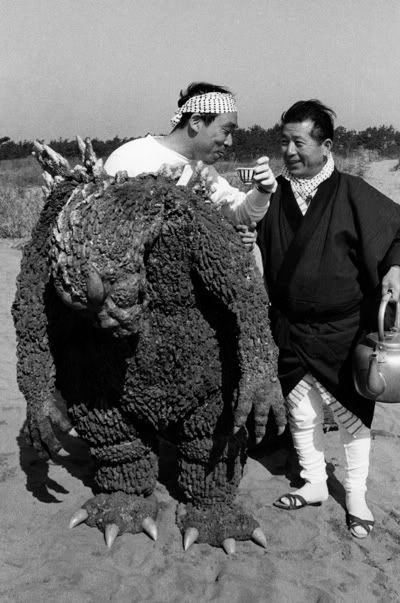
Haruo Nakajima taking a break between takes.
NEW YORK, November 9 – In Japanese kaiju (怪獣) films, the faces of the most memorable players are never seen on the silver screen. They are the kaiju actors who breathe life into fantastic monsters like Godzilla (ゴジラ) and Gamera (ガメラ). Suffering underneath thick layers of latex rubber, they lumbered around complex miniature cityscapes in order to create movie magic. They are literally where “the rubber meets the road.”
Monday, October 18, 2010
NYCC 2010: Saturday Funnies
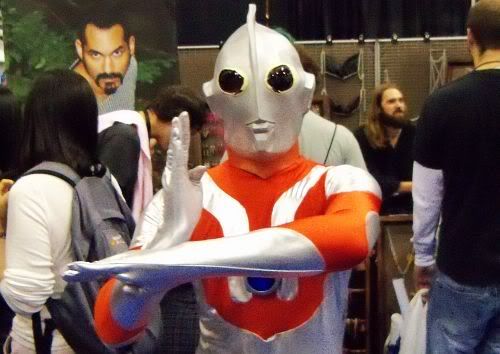
Ultraman (ウルトラマン) Cosplayer
New York, October 9 – Saturday is probably the busiest day during the New York Comic Con. I arrived early for many of the interesting panels including the Spotlight on Harper Collins, Digital Comics & Distribution, and Sushi Typhoon.
Vampires, Witches, and Zombies. Oh my...
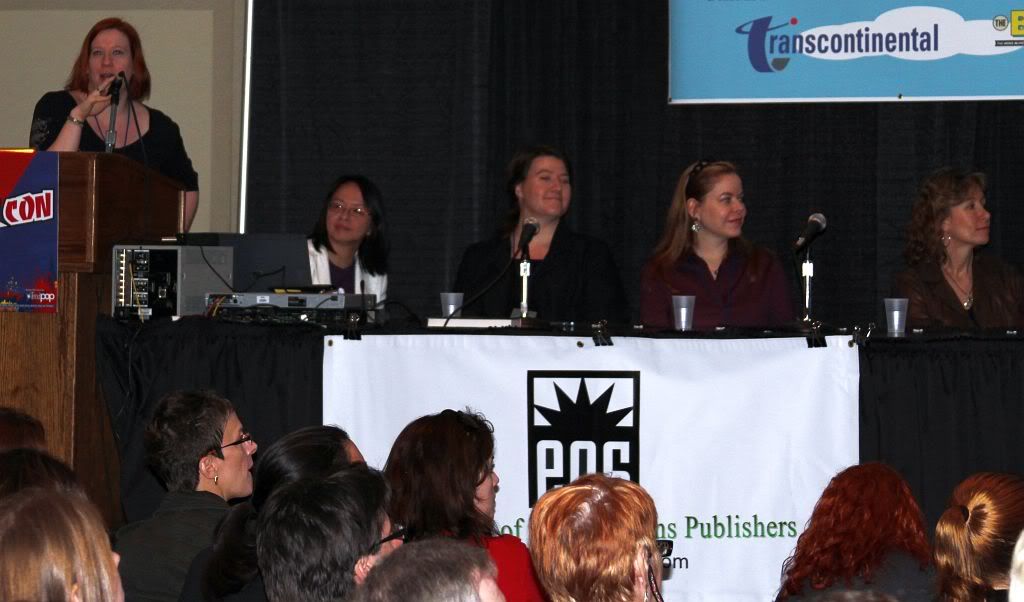
Spotlight on Harper Collins. Seated (Left to Right): Erika Tsang (editor), Margaret Ronald (author), Jeaniene Frost (author), and Pamela Palmer (author).
I popped into this panel to check out the announcements and support my cousin Erika Tsang. She is an Executive Editor at Avon Romance. The panel announced several supernatural romance fiction titles such as Majorie Liu's In the Dark of Dreams, Jeaniene Frost's Side of the Grave, and Kerrelyn Sparks' Vampire Mine. Despite the romance nature of the imprint, the line was filled with sexy vampires, powerful witches, and zombies invasions. The trend in romance fiction is leaning towards the supernatural with the popularity of book series like The Twilight Saga and The Southern Vampire Mysteries (True Blood).
Labels:
anime,
asian culture,
books,
comics,
conventions,
cosplay,
graphic novels,
indie comics,
Japanese,
Japanese Cinema,
literature,
manga,
merchandise,
movies,
NYAF,
NYCC,
OEL,
tokusatsu
Tuesday, October 12, 2010
NYCC 2010: The Brave and The Geeky
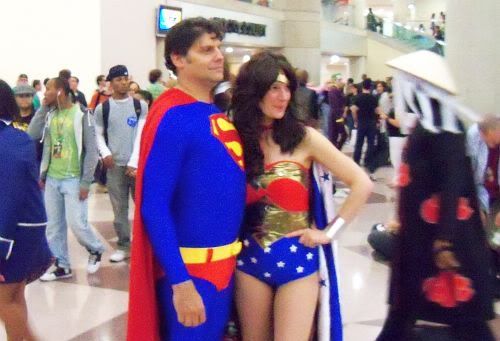
Cosplaying Couple posing as Superman and Wonder Woman.
New York, October 8 – Due to a late night pre-con party, I arrived to the New York Comic Con 2010 late on the Friday afternoon. There weren't too many interesting panels except the Aniplex one. I had a difficult time finding the press office to pick-up my badge, and the volunteers at registration had no clue. I wandered a bit and eventually got my badge. I headed over to the Aniplex panel.
Aniplex of America

Aniplex PR team. Hiroe Tsukamoto (right).
As I was waiting for the panel to begin, Anime News Network (ANN) Editor Chris Macdonald sat right in front of me. I've run into him at other conventions over the summer. I greeted him, and we were trading war stories about this year's anime con season.
Labels:
anime,
comics,
conventions,
cosplay,
graphic novels,
indie comics,
Japanese Cinema,
manga,
movies,
NYAF,
NYCC,
tokusatsu
Thursday, August 19, 2010
NYAFF 2010: Photographic Evidence

New York, July 8 – During the 2010 New York Asian Film Festival (NYAFF), I took hundreds digital photographs and several digital videos. I promised the Subway Cinema guys to post them, but my life got really busy. The images just sat on my hard drive for nearly a month until I could find the time to sort them. I compiled best ones for this photo essay post.
Except for the photographs attached to other blog posts, these are some of my favorite photos from NYAFF 2010: [Click Through Image for Higher Resolution]
Labels:
Chinese Cinema,
cosplay,
Indie Cinema,
Japanese Cinema,
Korean Cinema,
martial arts,
movies,
NYAFF
Thursday, August 5, 2010
SDCC 2010: Con Survival, Pop Candy Party, and Boris

San Diego, July 24 – I always assumed that con survival guides were weak veiled attempts at comedy. Come on… Do you really need someone to remind you of basic human functions like hygiene, hydration, and eating? It’s basic common sense. Even mindless Sims sprites know when to use the bathroom.
Then, the unthinkable happened. There was geek-on-geek violence in Hall H of the San Diego Comic-con. Stationed at the plushy table of the Giant Robot booth, I watched two squads of local police quickly marching across the convention center.
I’ve read quite a few con survival how to’s, and I don’t recall any lessons on self-defense (the zombie apocalypse ones don’t count). I guess it’s time to add some basic self-defense tips to those guides.
There were many rumors circulating in the exhibitor’s hall. The initial story described a confrontation ending in an attendee stabbing another one with a replica light saber (the geek’s weapon of choice). It’s perhaps the geekiest personal assault in history. When I read the actual news coverage, the victim was stabbed by a pen near his eye. He went to the hospital with minor cuts.
Labels:
anime,
asian culture,
comics,
concert,
conventions,
cosplay,
Filipino,
indie comics,
j-rock,
Japanese,
Japanese Cinema,
manga,
merchandise,
movies,
music,
SDCC,
tokusatsu,
toys
Wednesday, July 28, 2010
SDCC 2010: Crossroads and Connections

Plushy Stand at the Giant Robot booth
San Diego, July 22 – The San Diego Convention Center opened its doors for the first full day of Comic-con International. Standing behind the plushy Totoro (トトロ) dolls at the Giant Robot booth, I was prepared for the onslaught of attendees.
First David Choe Signing
Our first major event was a signing by David Choe. Choe has been a major artist and painter in the Los Angeles art scene for the last several years. His pop sensibilities and graffiti style artwork has garnered a huge following among both art collectors and street artists. It’s a balancing act that keeps Choe's work on the cutting edge of the avant-garde.

Line for Dave Choe signing
Even before Choe’s arrival, his fans were lining up for the event. They were eager to chat with the artist and get their stuff signed.
Labels:
anime,
art,
asian culture,
comics,
drinking,
graphic novels,
indie comics,
Japanese,
Japanese Cinema,
manga,
movies,
SDCC,
tokusatsu,
toys
Wednesday, July 21, 2010
NYAFF 2010: The Festival Spawned a Monster

Right to Left: Noboru Iguchi and Yoshihiro Nishimura
NEW YORK, July 3 – The Japan Society hosted a special international premiere of Mutant Girls Squad in conjunction with the New York Asian Film Festival (NYAFF) and the Sushi Typhoon label. It’s one of the first films produced under the new movie label.
Directed by three insanely talented Japanese filmmakers, the movie is an extremely violent picture with gallons of fake bloody. Essentially parodying American superhero comic book movies, a team of teenage mutant gravure idols takes over a local street mall. They proceed to kill everything that moves. I mean everything. It’s mostly a non-stop action gore fest with several outrageously funny moments.
Tuesday, July 20, 2010
NYAFF 2010: The Saitama Rap Game
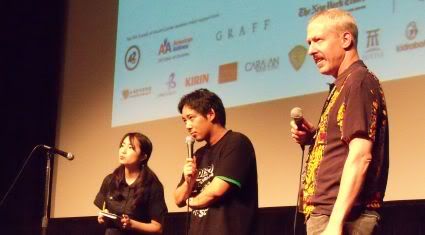
Yu Irie (center)
NEW YORK, June 29 – At the Walter Reade Theater, the New York Asian Film Festival (NYAFF) screened a Japanese indie hit film called 8,000 Miles (Saitama no Rappa). The movie was shown twice drawing huge crowds.
8,000 miles is a musical comedy about a group of unknown rappers in the Saitama prefecture (a suburb of Tokyo). It tackles serious social issues in Japan including the Asian economic crisis, NEETs (Not in Employment, Education or Training), parasite singles, and unemployment. It might seem like a very didactic film, but it’s not. The narrative maintains a funny and light-hearted tone by couching the issues in several hilarious scenarios. The director does a wonderful job at balancing the social message with a great deal of humor.
Labels:
Japanese,
Japanese Cinema,
movies,
music,
NYAFF
Wednesday, July 7, 2010
NYAFF 2010: Pink Double Feature with Asami
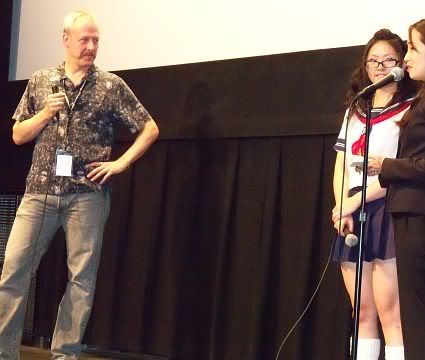
Schoolgirl Asami Q&A
NEW YORK, July 2 – The New York Asian Film Festival (NYAFF) and Pink Eiga hosted a pink film (ピンク映画) double feature at the IFC Center. It was a midnight screening that attracted a colorful crowd. This year’s pink film screening featured Groper Train: School Uniform Hunter and Japanese Wife Next Door Part 2.
It’s difficult to describe Japanese pink films because it has no analogous genre in western culture. It’s roughly a cross between exploitation films and soft core porn. Moreover, the genre was mainly developed as a response to strict censorship laws in Japan. All of the sex is simulated, and no genitalia are shown on screen. Most of the simulated sex scenes are awkwardly shot and hilariously bad.
Introduction to Groper Train: School Uniform Hunter
I get the feeling that the ridiculous sex scenes are purposefully crafted for comedic effect. It’s kinda hard to be serious when the audio cuts to cheesy music and the sound effects are canned.
Between the two feature films, Asami Sugiura (杉浦 亜紗美) (aka “Asami”) participated in a short Q&A with the folks at the NYAFF. Asami, who plays the female lead in Groper Train: School Uniform Hunter, discussed her career and the differences between pink films and Japanese Adult Video (AV).
Asami Q&A
Friday, July 2, 2010
USA Today: Japanese Monster Flicks Make Life Better
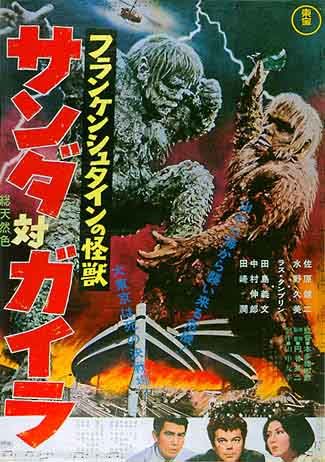
NEW YORK, July 2 – USA Today published my on-line article about daikaiju (big monster) movies. It's a guest writing piece for the Pop Candy column. Check it out!
USA Today: Japanese Monster Flicks Make Life Better
Special thanks to Whitney Matheson (the regular columnist) for letting me guest write for her. If you are a pop culture fiend, her daily Pop Candy column is a must read.
Enjoy your vacation, Whit!
NYAFF 2010: A Love Letter to Yumika
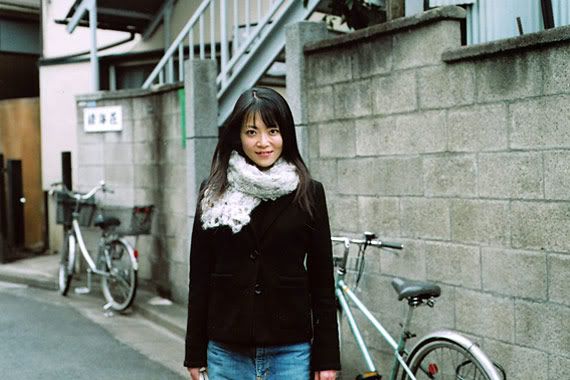
NEW YORK, June 30 – Yumika Hayashi (林由美香) was a prolific Japanese actress in the genre of pink films (ピンク映画) and pornographic videos. She has appeared in nearly 400 adult oriented movies and is probably best known for her work in the critically-acclaimed pink film called Lunchbox (熟女・発情 タマしゃぶり).
As a young filmmaker, Tetsuaki Matsue had a very memorable meeting with Yumika. During the encounter, she critiqued his work and said, “You have a long way to go.” Her words stayed with him, and the two became good friends.
When Yumika died suddenly at the age of 35, it was a complete shock to her friends and fans. Matsue was filled with grief and had difficulty talking about it. He decided to channel his feelings into a documentary film titled Annyong Yumika (あんにょん由美香).
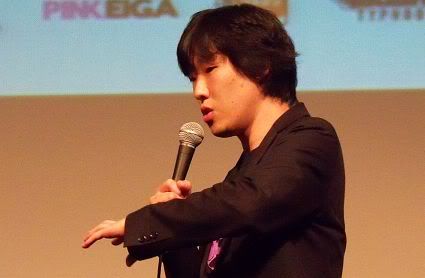
Director Tetsuaki Matsue
The documentary begins with the discovery of an obscure Korean pornographic video starring Yumika called Junko: Story of a Tokyo Housewife. It was an unusually joint Korean and Japanese production filled with bad dialogue and awkward sex scenes. Using the video as a guide, Matsue retraces Yumika’s steps trying to understand her enigmatic life. (Note: He uses many excerpts from the video in his documentary. If you’re offended by pornography, you might not want to watch it.)
Through candid interviews with Yumika’s lovers, the director attempts to piece together her strange and colorful life. They passionately describe their experiences with the porn actress, and some admit to still harboring strong feelings for her. In many respects, the movie is less of a documentary and more of a love letter to Yumika.
When one of Yumika's directors tried to convince her to leave the adult film industry, she declined. He argued that she will have a better life doing a more respectable job. She replied, “I will cease to be me.”
Annyong Yumika, Q&A with Tetsuaki Matsue
Related Links:
Monday, April 5, 2010
The Last Video Rental Store

JERSEY CITY, April 5 — The last local video rental store in my neighborhood is finally closing its door after nearly twenty years. It’s the latest victim of digital media and high speed internet distribution. It’s quite sad really. I spent most of my formative years renting VHS cassettes.
As soon as my dad bought our first Panasonic VCR, I remember spending most of my childhood walking the narrow aisle of the video store looking for interesting VHS tapes. It was only a dollar to rent a single VHS for a day, and it was a bargain.
I frequently rented martial arts, horror, and crappy B-movies. It’s an informal film education that shaped my taste as moviegoer. I spent my younger days watching rented movies like Chinese Connection, Blood Sport, Dracula Versus Frankenstein, Swamp Thing, and Godzilla 1985 (ゴジラ). According to my Netflix queue, my taste in movies hasn’t really changed much… Jeez.
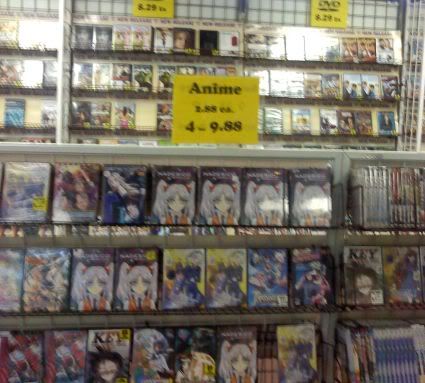
In the early 1990s, I rented some of the first anime titles legally released by Central Park Media, AnimEigo, U.S. Renditions and Streamline Pictures. Most of the releases were OVAs like M.D. Geist, Bubble Gum Crisis, Appleseed, and Gunbuster. I also remember the anime section being labeled "Japanimation". Along with a local tape trading circle, the video rental store became a good source for my voracious anime addiction.
As I walk past the last local video rental store, it was holding a huge "going out of business" clearance sale for all their DVDs. Regular feature film DVDs were priced at $8.29, and Anime DVDs were going for $2.88 each. I'm going to miss it.
Labels:
anime,
Chinese Cinema,
Japanese Cinema,
movies,
nostalgic,
random crap,
tokusatsu
Wednesday, July 22, 2009
Part IV: Otaku War Journal: Tuesday Night Anime
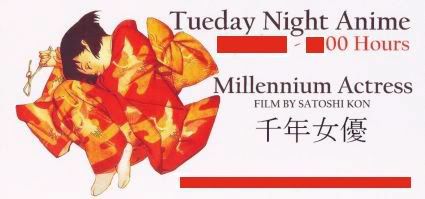
Location Bravo, Somewhere in the Arabian Desert – This is my fourth installment of the Otaku War Journal. If you want to read the other posts, click here.
In the sands of the desert, my old school otaku social behaviors resurfaced again. (Is that an oxymoron “social otaku”?)
After talking to other people at the base, I discovered a small cluster of anime fans. I thought that it might be a good idea to set-up a series of weekly anime showings. The idea harkens back to old anime clubs which usually consists of one fan with a huge cache of anime organizing regular local screenings. In my case, I brought a sizable amount of anime with me to the war.
Before I could begin event planning, I needed to choose a name for my little endeavor. I originally wanted to call it “Friday Night Anime”. It was reference to an old 80s television show called “Friday Night Videos”, a program that showcased a two hour block of music videos on NBC.
I tried to schedule “Friday Night Anime” in the local projection tent. I found out that Friday nights were booked solid, and it was impossible to reserve. Tuesday Nights were the only open block of time. So, I had to change the name from “Friday Night Anime” to “Tuesday Night Anime”. Hence, the name…
Your results may vary. I never established any consistent number of people. It was difficult attracting a regular audience.
The full feature anime movies attracted the largest audiences (e.g. Vampire Hunter D: Bloodlust (バンパイアハンターD), Tokyo Godfathers (東京ゴッドファーザーズ), and Fullmetal Alchemist the Movie: Conqueror of Shamballa (劇場版「鋼の錬金術師 シャンバラを征く者」)). Movies are easier for non-anime fans to watch. They don’t require any background knowledge or prior character development, and they are mostly standalone narratives.

The largest number of people showed up for my screening of Nausicaä of the Valley of the Wind (風の谷のナウシカ). Hayao Miyazaki (宮崎 駿) always seems to draw the biggest crowds. It was an English dub which also helped non-hardcore anime fans.
Any viewers that I gained from the Nausicaä screening were quickly lost when I showed Cromartie High School (魁!!クロマティ高校) the following week. Most of the audience walked out completely baffled. The worst received anime were: Cromartie High, Spirit of Wonder (スピリットオブワンダー), Mind Game (マインド・ゲーム), and Nerima Daikon Brothers (おろしたてミュージカル 練馬大根ブラザーズ).
I had a few regulars. They were mostly ardent anime fans prior to the war and familiar with some of the shows that I was screening. I met some people who you wouldn’t suspect of being an anime fan. Others were even more surprised that there was even an anime fan group in a warzone. After my tour was over, I even managed to pass on the Tuesday Anime Night event to two viewers to host.
In the end, I enjoyed hosting Tuesday Anime Night. It kept me occupied on my down time and gave me something to “look forward to” every week. Regardless of the daily stress of living in a warzone, I could always say to myself: “Tuesday Night Anime is only a few days away.”
Labels:
anime,
Japanese,
Japanese Cinema,
movies,
otaku war journal
Monday, July 6, 2009
Blood: The Last Vampire Poster
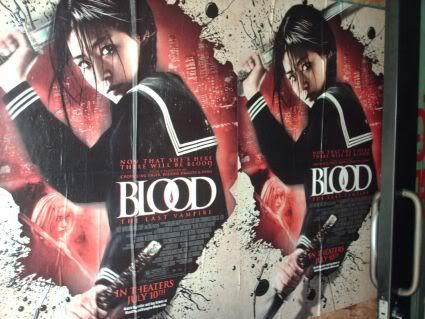
NEW YORK, July 5 – I saw a screening for this film a couple of weeks ago. It was an interesting take on the franchise. It doesn't refer to Blood+, the television anime. Instead it is based more heavily on the original anime film. Fans of the franchise should check it out.
Labels:
Japanese,
Japanese Cinema,
Movie Review,
movies
Saturday, July 4, 2009
NYAFF09: The Splatter High School Comedy
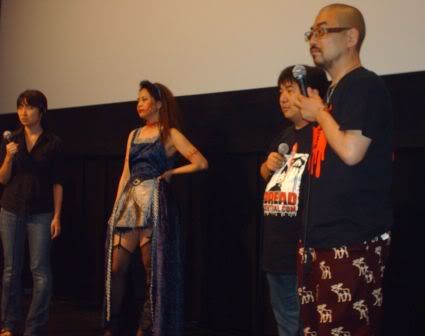
NEW YORK, June 29 – I attended the second showing of Vampire Girl Versus Frankenstein Girl (吸血少女対少女フランケン) at the IFC Center (323 Sixth Avenue). It was being screened as a part of the New York Asian Film Festival 2009.
Based on a manga by Shungiku Uchida (内田春菊), the film is centered on two supernatural high school girls. One is a vampire; the other one is a Frankenstein monster. Both engage in deadly battle for the affections of a single boy. Every scene is filled with lowbrow humor and gallons of fake blood.
The movie is hilarious, but the funniest scenes are ones involving the school clubs. Each club is based on a real Japanese teen trend such as wrist cutting, ganguro (ガングロ), and goth-loli (ロリータ・ファッション) girls. It takes each trend to the most ridiculous extreme for great comedic effect. I especially found the high school wrist cutting competition to be very funny.
The film is the brain child of two Japanese directors, Yoshihiro Nishimura (西村喜廣) and Noboru Iguchi (井口昇). They were at the screening to promote their movie in the United States. Their introduction was more of a two man stand-up comedy routine than a movie introduction. They had a great sense of humor and entertained the audience before the film. Nishimura called their film a “splatter high school comedy”.
After the film, they stayed for a “question and answer” session. Nishimura also did some make-up work during the film and displayed a female model sporting the Frankenstein make-up.
Vampire Girl Versus Frankenstein Girl is probably my favorite film from the entire festival. I had a blast! If you have a twisted sense of humor and an appetite for low-budget gore, you should definitely see this movie.
Related Links:
Labels:
asian culture,
Japanese,
Japanese Cinema,
Movie Review,
movies,
NYAFF
Sunday, June 28, 2009
NYAFF09: A Bloody Samurai Zombie Mistake
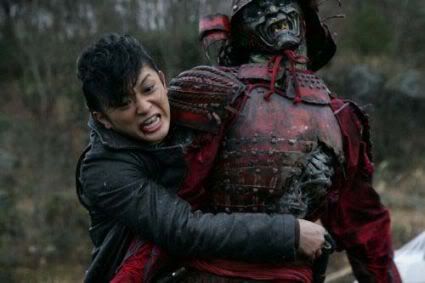
NEW YORK, June 26 – I was completely stoked about going to see Vampire Girl Versus Frankenstein Girl (吸血少女対少女フランケン) with some friends. I bought tickets online, but there was a bit of a mix-up at the IFC Center Box Office (323 Sixth Avenue). Apparently, if you purchase a “10-PACK” online for the New York Asian Film Festival, you have visit the box office and declare that you want tickets for a particular movie. Now under the online purchase page for Vampire Girl Versus Frankenstein Girl, you see these options:

There are no notes or warnings about requiring the customer to declare a ticket preference. I assumed that they were all for Vampire Girl Versus Frankenstein Girl. I checked the day prior to the screening about getting my tickets early, and the IFC Center employee said to wait until the day of the screening. I show up to the day of the screening, and I can’t get my tickets. They're sold out.
The employee behind the glass pointed at a black-and-white piece of paper that was taped to the glass. It states the fine print which requires 10-PACK customer to declare the particular movie and number of tickets desired.
Now, my receipt said “Vampire Girl Versus Frankenstein Girl” followed by the description “10-PACK”. The manager eventually offered a refund, and I was thoroughly pissed. I asked my friends Tim, Frank, and Jerette if they wanted to see the next movie, Yoroi: Samurai Zombie (鎧 サムライゾンビ). They agreed, and we decide to watch the next film.
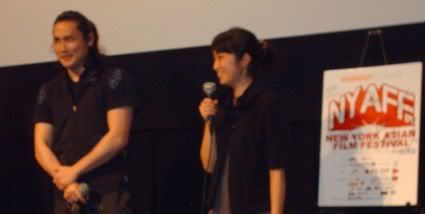
Yoroi: Samurai Zombie is freakish Japanese horror film which is one part Benny Hill and one part Friday the 13th. Ghoulish looking monsters wearing samurai armor are chasing a couple of criminals and a family through a deserted village. Excessive gore, pools of blood, and slapstick comedy are the main ingredient to this film. It kinda reminds me of Takashi Miike’s (三池 崇史) films. It was bizarre and uncomfortably comedic.
Tak Sakaguchi (坂口拓), the director and stuntman, introduced the movie. He talked about his involvement and the use of his talented stunt team. He especially emphasized his unusual fondness for running people over with cars.
Related Links:
Labels:
Japanese,
Japanese Cinema,
Movie Review,
movies,
NYAFF
Tuesday, March 11, 2008
REVIEW: Appleseed: Ex Machina
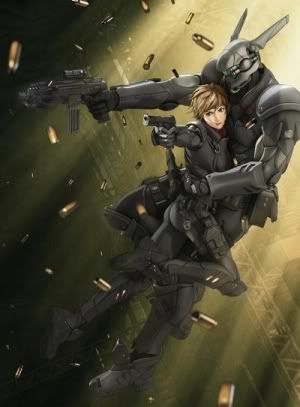
NEW YORK, March 8 — Appleseed: Ex Machina is the latest sequel to the popular Appleseed franchise. I had the opportunity to view the limited theatrical release of the film at the Independent Film Center (IFC) Center (323 Sixth Avenue). The IFC Center only showed two midnight screenings of Appleseed: Ex Machina on Friday (March 7) and Saturday (March 8). I attended the Friday midnight showing with a couple of my otaku friends.
After the screening, I walked out of the small theater with mixed feelings about the film. It seemed pretty standard for the 3D anime genre (Appleseed and Final Fantasy VII: Advent Children). The action and special effects scenes were amazing, but the computerized acting was stiff and unimpressive.
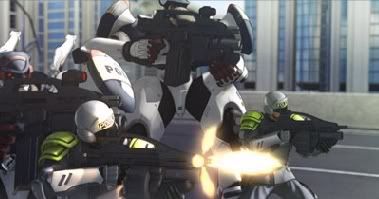
In terms of hardcore actions, Appleseed: Ex Machina does deliver the high intensity action scenes. Deunan’s firefights were completely adrenaline pumping. She would leap headlong into combat with guns blazing. The most energetic points of the action would be accompanied by slow motion. During the first few action scenes, the acrobatic gunplay and slow motion seemed very John Woo, but I felt something missing. I said to myself, "this film needs some white birds to fly across the frame in order to make it a Woo film." At about midway point through the film, Briareos had an amazing aerial fight scene and white doves fly across the screen several times. I almost shouted, "that's the Woo".
The character development and dialogue were very rough. The digital characters looked like lifeless dolls trying to act. The dialogue sequences seemed closer to puppeteering than live action acting. The humor was also a little forced. For example, the film had small comedic moments between the main characters, but the CGI expressions and physical acting failed to carry the jokes. The film was littered with these failed joke deliveries. In its defense, very few 3D animated films can capture the flow and grace of live action acting.

In a technical sense, there are a few visual improvements in the movie. The 3D skins were amazing. The textured clothing skins were very tactile. The leather materials looked like leather. The lighting was a huge improvement over the 2004 Appleseed film. Shinji Aramaki tried to implement a softer natural light instead of stark lighting in the previous Appleseed movie. They also greatly improved the cell shading used on the 3D models.
On another note, this film is stacked with a lot of talented creators. Shinji Aramaki (Appleseed and Metal Skin Panic: MADOX-01) directed, and John Woo (A Better Tomorrow and A Better Tomorrow III) produced. Masaki Yamada (Samurai Champloo and Ergo Proxy) did the character designs. They also managed to get Atsushi Takeuchi (Neon Genesis Evangelion: The End of Evangelion, Naruto: Konoha Sports Festival, and Patlabor 2: The Movie) and some members of Production I.G. to do a few sequences and storyboards on the film.
Appleseed: Ex Machina - Trailer
Overall, Appleseed: Ex Machina was a very exciting and enjoyable film with some minor problems. If you want to just strap into a seat and enjoy an action packed ride, this is the movie for you. Most otaku will enjoy the amazing action and computerized sets. It was a feast for the eyes.
The official Appleseed: Ex Machina DVD release date is March 11, 2008. The movie will be available in both standard DVD and Blu-ray DVD formats.
Related Links:
Labels:
anime,
Japanese,
Japanese Cinema,
Movie Review,
movies
Tuesday, December 25, 2007
REVIEW: Ishirô Honda's Latitude Zero
 NEW YORK, December 25 — Finally, a Special Edition Double DVD of Latitude Zero (aka "Ido zero daisakusen") has been released in the United States (Release Date: December 11, 2007). It was released by Tokyo Shock, a subsidiary of Media Blasters.
NEW YORK, December 25 — Finally, a Special Edition Double DVD of Latitude Zero (aka "Ido zero daisakusen") has been released in the United States (Release Date: December 11, 2007). It was released by Tokyo Shock, a subsidiary of Media Blasters.Latitude Zero is an underwater tokusatsu adventure by Ishirô Honda, the director of Gojira. It's a sci-fi film centered on Latitude Zero, an Atlantis-like underwater utopia. It's a classic Toho Studios production.
First, I want to address the matter of the packaging. The packaging is pretty stripped down for a "special edition". I was hoping for more extras and liner notes, instead the box was filled with Media Blasters advertisements. This advertising stuffing included a fold-out catalogue and a DVD of trailers. It was disappointing.

When "cult" films such as Latitude Zero are transferred to DVD, they are frequently victims of poor packaging and stripped down DVD authoring. Media companies just produce these DVD releases with very little creativity or care. The Latitude Zero release follows this trend of bland packaging and presentation.
Tokyo Shock could have paid a writer and a graphic designer to create an interesting booklet and box cover. It would cost very little money to produce.
Let’s get back to the film...
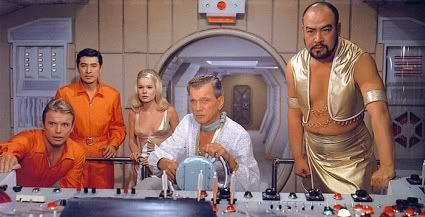
Crew of the Alpha submarine.
Before I reviewed this film, I read a lot of internet reviews on Latitude Zero. Many mainstream movie reviewers gave this film a bad review. However, I don't think it's really that bad. Latitude Zero has its problems, but it's a decent film. It is just misunderstood.
I understand that Latitude Zero is not for everyone. For many mainstream movie goers, many standard Japanese tokusatsu films (such as Gojira) are perceived as too weird and sometimes incomprehensible. Guys wearing large rubber monster costumes are still a little alien to western audiences.
However, Latitude Zero is just a step beyond the standard tokusatsu fare. This film was Honda's attempt to create a mixture of a western style sci-fi adventure with Japanese visual effects. He was trying to target both an American and Japanese audience simultaneously.

Capt. McKenzie (Cotten) catches a bullet with his bare hands.
The cast was a unique mix of western and Japanese actors. The most notable western actors were Cesar Romero (The Joker from TV's Batman) and Joseph Cotten (Citizen Kane). They are joined by Akira Takarada (Gojira: Fainaru uôzu, Gojira, and Kingdom Hearts Video Games) and Masumi Okada (Brother Michael from TV's Shogun). Takarada is veteran Godzilla actor and a staple of Toho Pictures. His tokusatsu career spans the entire history of Godzilla films from the original 1956 Godzilla film to Godzilla: Final Wars.
The movie was also filmed in English, and many of the Japanese actors had to learn English. Some of the Japanese actors had the English script broken down into phonetic katakana in order to learn it. If you listen carefully to the Japanese actors, you will hear extra syllables and trailing sounds at the end of words. This is mostly due to learning English from reading the katakana phonetics.
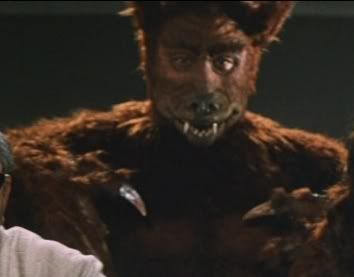
Mutant humanoid bat henchmen.
The story of Latitude Zone begins in the Pacific Ocean. A research team is lowering a deep sea diving bell into the ocean. Two Japanese scientists (Takarada and Okada) and an American journalist (Richard Jaeckel) are diving into the deepest part of the ocean in order to study temperature shifts. An underwater volcano suddenly erupts, and their deep sea diving bell crashes to the bottom. They are quickly rescued by Captain Craig McKenzie (Cotten) and his uncanny submarine crew. After the rescue, the Alpha, McKenzie's submarine, is quickly pursued and attacked by the Black Shark, Doctor Malic's (Romero) submarine. An action filled underwater pursuit begins.
If you are fan of early sci-fi films, Latitude Zero will be a bizarre cinematic treat. Most of Latitude Zero's story deals with the concepts of a utopian society and the miracle of scientific progress during the early 20th century. The film portrays science as both a destructive force and a nurturing one. The ambivalent feelings toward scientific progress are a familiar theme to many sci-fi movie fans. In many respects, Latitude Zero is very similar to The Thing from Another World (1951), Voyage to the Prehistoric Planet (1965), and Forbidden Planet (1956).
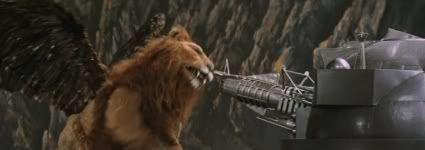
Giant griffin versus a submarine.
This film also has a good helping of Kaiju fun. It is an Ishirô Honda film after all. The crew of the Alpha battles humanoid bat creatures, giant rats, and a large furry Griffin monster. Many kaiju fans will also recognize the orchestral score. Music for the film was provided by Akira Ifukube, composer for most of the Godzilla films.
Latitude Zero does suffer from some pacing issues. The exposition scenes are painfully slow in the movie. Honda tried to stuff a political message into the long dialogue scenes, but it was completely awkward. He was trying to argue that the Cold War has tainted the noble pursuit of scientific research and human governments could not be trusted. It was a little too didactic, and it was a drag on the story.
In the end, Latitude Zero is not for everyone. However, if you enjoy a bizarre cinematic sci-fi experience, I highly encourage you to pick-up Ishirô Honda's Latitude Zero.
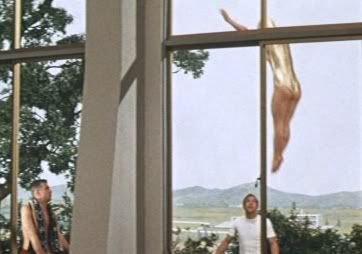
Ohh... Did I mention that they have girls on trampolines!
Labels:
asian culture,
Japanese Cinema,
Movie Review,
movies,
review,
tokusatsu
Saturday, December 1, 2007
REVIEW: Akira Kurosawa's Drunken Angel (Criterion Collection)
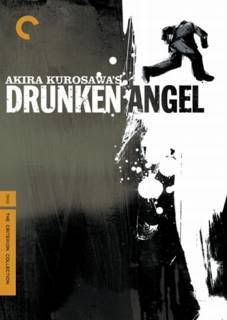
NEW YORK, November 30 — The folks at Janus Films and Criterion Collection recently released the latest high-definition digital transfer of Akira Kurosawa's Drunken Angel (released November 27, 2007).
As part of their standard production, Drunken Angel is a masterfully authored DVD with an amazing accompanying booklet. The packaging reminds me of old rock albums that were accompanied with original artwork and great liner notes. Packaging and good liner notes are slowly becoming a lost art with cheap DVD releases, Thinpaks, and direct downloads.
The Criterion DVD also has great extras like old archive interviews with Kurosawa and commentary by Donald Richie. Donald Richie is the author of A Hundred Years of Japanese Film: A Concise History.

Drunken Angel's Criterion Collection Packaging and Liner Notes.
I have to confess that I'm a huge Akira Kurosawa fan. I have most of Kurosawa's movies in the restored Criterion Collection editions.
Drunken Angel is not characteristic of Kurosawa's later samurai movies like Rashômon or Seven Samurai. It's closer in tone and content to his earlier films dealing with post World War II Japan such as Stray Dog and Ikiru. It deals with many of Japan's post war problems such as crime, disease, and poverty. These themes are the pillars of Kurosawa's early noir classics.
In many ways, Drunken Angel is a precursor to Kurosawa's more famous Ikiru. Ikiru is one of my all time favorite films. Both films deal with issues of fatal diseases and poverty in Japanese society. Drunken Angel seems a little raw in comparison with Ikiru. In this film, Kurosawa was still looking for his own voice and style. Some scenes seem like pale imitations of Italian neorealism and Russian silent films. There were also some scenes that didn't seem like Kurosawa at all. (Note: Both of these styles are hugely influential on Kurosawa's own directorial style.)
The main story centers on the two main characters played by Takashi Shimura and Toshirô Mifune. Both Shimura and Mifune play notable samurai in Kurosawa's Seven Samurai movie. In Drunken Angel, Shimura plays a drunken doctor, who treats poor patients in his small clinic. Mifune plays a gangster that is diagnosed by Shimura with a deadly case of tuberculosis. Shimura directly confronts the gangster with his illness.
Shimura's directness was shocking to a Japanese audience because of Japanese medical practices at the time.
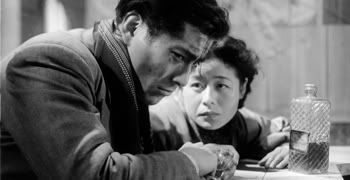
In the 1940s and the 1950s, it was common for Japanese doctors to lie to their patients about deadly ailments like cancer and tuberculosis. Japanese doctors believed that news of a fatal disease would be like handing a death sentence to a patient. The news would impair a patient from living the rest of their lives with any sense of normalcy. Kurosawa often criticized this medical practice in his early films. The practice of concealing fatal diseases prevented Japanese society from dealing directly with the problems of poverty and poor health.
In post war Japan, many Japanese died of deadly diseases from poor living conditions, poor hygiene, and polluted water. Disease and hygiene became very serious issues, and Kurosawa explores these issues in Drunken Angel.
If you don't mind some of the raw elements, I recommend that you watch Drunken Angel. It is not one of Kurosawa more polished films, but it does not disappoint. The film has passionate performances from both Shimura and Mifune, and Kurosawa's directing and editing are emotionally powerful.
Related Links:
Criterion Collection: Drunken Angel
IMDb: Akira Kurosawa
Wikipedia: Akira Kurosawa
Wikipedia: Tuberculosis
Labels:
asian culture,
drinking,
history,
Japanese Cinema,
Movie Review,
movies,
review
Subscribe to:
Posts (Atom)

